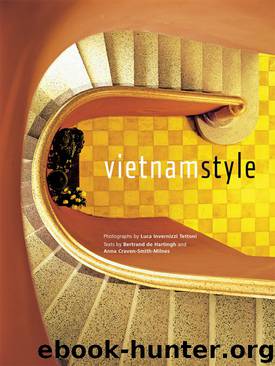Vietnam Style by Bertrand De Hartingh & Anna Craven-Smith-Milnes

Author:Bertrand De Hartingh & Anna Craven-Smith-Milnes
Language: eng
Format: epub
ISBN: 978-1-4629-0685-7
Publisher: Tuttle Publishing
The Hanoi Opera house, one of the city’s most striking landmarks, was built between 1901 and 1911. Harshly criticized at the time as a folly of grandeur, it nevertheless perfectly fitted French plans for both the urban reconstruction of the city and its cultural revival. It was extensively renovated in the late 1990s, and has been reincarnated as the artistic center of Hanoi, playing host to many Vietnamese and foreign artists.
The only buildings that deviated from this colonial form were the museums built by the French. These museums, whose aim was to cement the fusion of French science with Indochinese cultures, were carefully designed and built. What is now the Hanoi National Museum of History was first set up in 1908 as the Museum of Archaeology and Ethnography and was housed in the former General Governor Palace. (Later this was used as the Indochinese University.) In 1926, however, Ernest Hébrard was appointed by the EFEO to design a new museum building. It took seven years for Hébrard to build the Musée Louis Finot, so named after EFEO’s first director. Hébrard, who was strongly opposed to the use of the gothic style used by his colleagues in Vietnam, tried to mix local influences with French architectural patterns. The result can be seen either as a pastiche of a Chinese building as understood by a Westerner or as a culturally sensible building that pays homage both to local architectural traditions and climate requirements. Whatever one’s opinion, it perfectly exemplifies the “Indochinese style” that became the Hébrard trademark. The same can be said about the Cham Museum in Danang. Built in 1916 by Henri Parmentier in order to shelter the EFEO’s collection of cham statues, it was extended in the 1930s and inaugurated in 1936 by the Emperor Bao Dai. Since its location was first designed to be a garden, the museum was built as an open-air space with the idea that visitors should feel more that they were in a park than in a classic museum. This kind of setting, where the arts of Vietnam were showcased with immediate access, was not usual. Generally architects preferred to stick to classical formulae. But in this case, probably because Henri Parmentier was also the main collector and researcher of the art displayed in the museum, an attempt was made to match the method of display with the “soul” carried by the objects.
Download
This site does not store any files on its server. We only index and link to content provided by other sites. Please contact the content providers to delete copyright contents if any and email us, we'll remove relevant links or contents immediately.
| Automotive | Engineering |
| Transportation |
Whiskies Galore by Ian Buxton(41879)
Introduction to Aircraft Design (Cambridge Aerospace Series) by John P. Fielding(33064)
Small Unmanned Fixed-wing Aircraft Design by Andrew J. Keane Andras Sobester James P. Scanlan & András Sóbester & James P. Scanlan(32743)
Craft Beer for the Homebrewer by Michael Agnew(18140)
Turbulence by E. J. Noyes(7936)
The Complete Stick Figure Physics Tutorials by Allen Sarah(7307)
Kaplan MCAT General Chemistry Review by Kaplan(6867)
The Thirst by Nesbo Jo(6828)
Bad Blood by John Carreyrou(6552)
Modelling of Convective Heat and Mass Transfer in Rotating Flows by Igor V. Shevchuk(6391)
Learning SQL by Alan Beaulieu(6211)
Weapons of Math Destruction by Cathy O'Neil(6146)
Man-made Catastrophes and Risk Information Concealment by Dmitry Chernov & Didier Sornette(5921)
Digital Minimalism by Cal Newport;(5664)
Life 3.0: Being Human in the Age of Artificial Intelligence by Tegmark Max(5474)
iGen by Jean M. Twenge(5366)
Secrets of Antigravity Propulsion: Tesla, UFOs, and Classified Aerospace Technology by Ph.D. Paul A. Laviolette(5309)
Design of Trajectory Optimization Approach for Space Maneuver Vehicle Skip Entry Problems by Runqi Chai & Al Savvaris & Antonios Tsourdos & Senchun Chai(5011)
Pale Blue Dot by Carl Sagan(4912)
